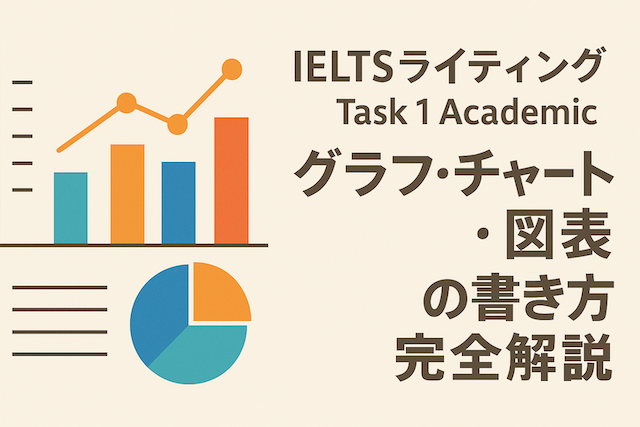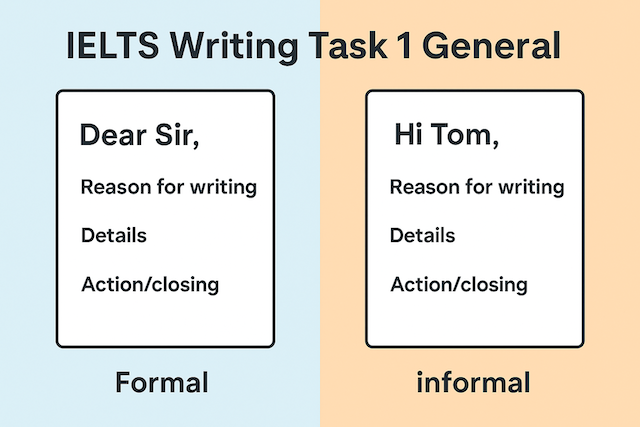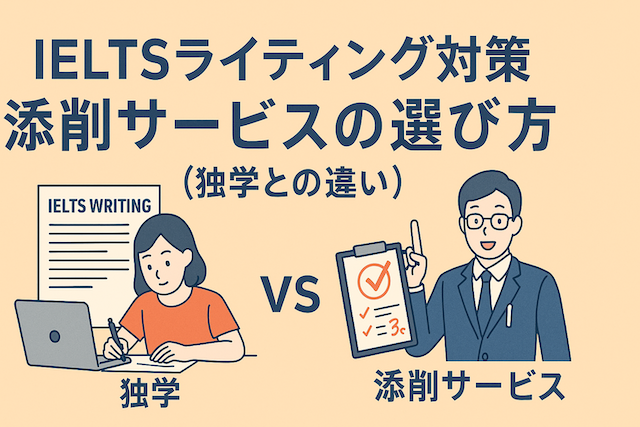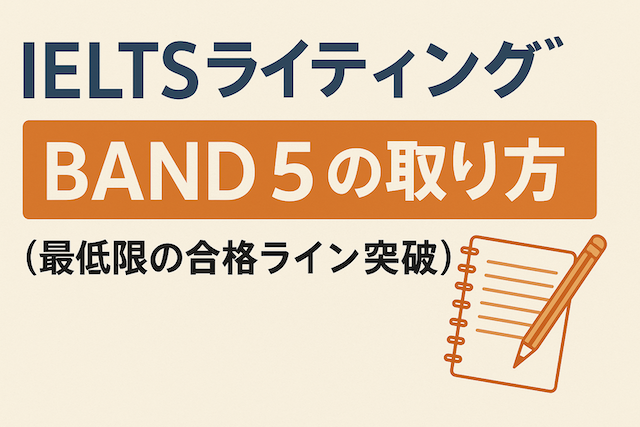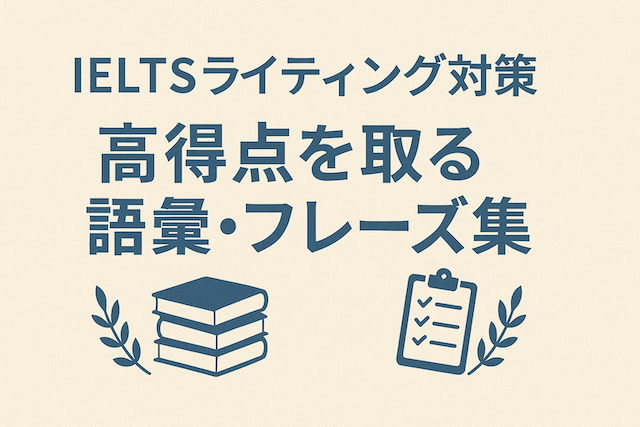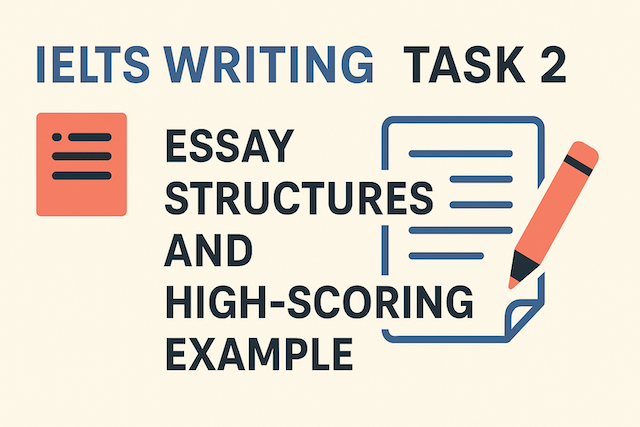IELTSライティング Task 1 Academic グラフ・チャート・図表の書き方完全解説
はじめに
IELTSライティングのTask 1(Academic)は、多くの受験者にとって独特な難しさを感じるパートです。与えられるのは グラフ・チャート・図表 といった「視覚的データ」。それを 150語以上の英語で客観的に説明する ことが求められます。エッセイのように自分の意見を述べるのではなく、提示された情報を正確かつ論理的にまとめるスキルが必要になるため、独学では書き方のコツを掴みにくい部分でもあります。
試験時間全体は60分ですが、そのうちTask 1に割けるのはおよそ20分。短時間で構成を考え、主要な特徴を抽出し、読み手に伝わる英語で文章化しなければなりません。ここでつまずくとTask 2(エッセイ)に十分な時間が残らないため、効率的に得点を確保することが戦略上とても重要です。
本記事では、Task 1 Academicの出題形式の種類から、解答の基本構成、グラフやチャートの種類ごとの攻略法、頻出語彙・表現まで、徹底的に解説します。これを読むことで、どのような問題が出ても「型」に沿って安定した解答ができるようになることを目指します。
Task 1 Academic 出題形式の種類
IELTSライティング Task 1(Academic)では、与えられる資料は必ず「視覚的なデータ」や「図解」です。つまり、数字や図を読み取り、それを英語で客観的に説明する力が求められます。出題パターンは大きく分けて以下の種類があり、それぞれに書き方のコツがあります。
1. 折れ線グラフ(Line Graph)
-
時系列の変化を表す典型的な問題。
-
「増加・減少・変動」を正しく表現する必要がある。
-
動詞例:increase, decline, fluctuate, remain stable
2. 棒グラフ(Bar Chart)
-
異なるカテゴリーやグループを比較する問題。
-
「どちらが多い/少ない」「差が大きい/小さい」など比較の言い回しを多用。
-
表現例:higher than, in comparison with, slightly lower
3. 円グラフ(Pie Chart)
-
全体100%を分割した割合を示す問題。
-
割合を比較・対照し、特徴的な構成を説明する。
-
表現例:account for, make up, constitute, the largest proportion
4. 表(Table)
-
数字が羅列されたデータ表。
-
単に数値を読み上げるのではなく、傾向・最大値・最小値に注目して整理することが重要。
5. 地図(Map)
-
ある場所の変化(before / after)が出題される。
-
建物や土地利用の変化を説明する語彙が必要。
-
表現例:was replaced by, was converted into, expanded, demolished
6. プロセス図(Process Diagram)
-
工程や手順の流れを示す図。
-
順序を正しく、受動態を使って説明するのが基本。
-
表現例:first, subsequently, eventually, is produced, is processed
7. 複合型(Combination)
-
例:棒グラフ+円グラフ、表+折れ線など
-
複数の資料をまとめて説明するため、比較力・要約力がより試される。
基本的な解答構成(4パラグラフ)
Task 1 Academic は「150語以上」という制約の中で、明確な型に沿って書くことが最も効率的です。多くの受験者が安定して得点を取るために使うのが 4パラグラフ構成 です。
1. イントロダクション(Introduction)
-
問題文を 言い換え(Paraphrase) して書き始める。
-
テンプレートを覚えておくと安心。
-
例:
-
Task statement: The chart shows the percentage of households with internet access in three countries between 2000 and 2020.
-
Paraphrased: The chart illustrates the proportion of households that had access to the internet in three nations from 2000 to 2020.
-
2. オーバービュー(Overview)
-
採点基準で高得点を狙ううえで最重要。
-
全体的な傾向・特徴をまとめる。数字の詳細は不要。
-
例:
-
Overall, all three countries experienced a rise in internet access, with Country A consistently leading while Country C showed the most dramatic growth.
-
3. 詳細パラグラフ1(Details 1)
-
重要な数値や変化を具体的に説明。
-
時系列なら「開始時点と終了時点」「急激な変化」に注目。
-
比較型なら「最も高い/最も低い」データに注目。
4. 詳細パラグラフ2(Details 2)
-
残りのデータを整理して説明。
-
他のカテゴリーや時期と比較しながらまとめる。
-
データの「対照」を加えると論理的で読みやすい。
✅ ポイント
-
必ず「イントロ+オーバービュー」で全体を押さえたうえで「詳細」で深掘りする流れにする。
-
数字はすべて書く必要はなく、特徴的なデータをピックアップするのが高得点の鍵。
グラフ別攻略法
Task 1 Academic の最大のポイントは、グラフや図表の種類ごとに書き方の型を理解しておくことです。ここでは出題頻度の高い順に、効果的な攻略法を整理します。
1. 折れ線グラフ(Line Graph)
-
特徴:時系列の変化を表す。
-
見るべきポイント:
-
増加・減少の方向
-
急激な変化 or 緩やかな変化
-
最初と最後の数値、ピークやボトム
-
-
よく使う表現:
-
increase, rise, grow, climb(増加)
-
decrease, decline, drop, fall(減少)
-
fluctuate, remain stable, level off(変動・安定)
-
-
例文:
-
The number of internet users in Country A rose steadily from 2000 to 2010, before leveling off in the following decade.
-
2. 棒グラフ(Bar Chart)
-
特徴:異なるカテゴリーを比較。
-
見るべきポイント:
-
どのカテゴリーが最も高い/低いか
-
類似点・相違点
-
-
比較表現が重要:
-
higher than, lower than, in contrast, whereas
-
-
例文:
-
In 2015, sales of smartphones were significantly higher than those of tablets, whereas laptops remained relatively stable.
-
3. 円グラフ(Pie Chart)
-
特徴:割合やシェアを示す。
-
見るべきポイント:
-
最大・最小の割合
-
構成比の変化(2つ以上の円グラフの場合)
-
-
頻出表現:
-
account for, constitute, make up, represent
-
-
例文:
-
In 2020, renewable energy accounted for 35% of total electricity production, becoming the largest source.
-
4. 表(Table)
-
特徴:複数の数値データを提示。
-
注意点:単なる数値の羅列はNG → 傾向や特徴をまとめる。
-
戦略:
-
最大値・最小値を強調
-
複数年の比較なら変化に注目
-
-
例文:
-
The table shows that while Country A had the highest literacy rate throughout the period, Country B experienced the most significant growth.
-
5. 地図(Map)
-
特徴:場所の変化を比較(before/after)。
-
重要ポイント:
-
新しい施設が建設されたか
-
建物や道路の拡張・撤去
-
-
頻出語彙:
-
was converted into, was replaced by, expanded, demolished
-
-
例文:
-
The park was replaced by a shopping mall, and a new road was constructed to connect the residential area with the city center.
-
6. プロセス図(Process Diagram)
-
特徴:工程やサイクルを説明。
-
戦略:
-
順序を明確に、受動態で表現する。
-
first, subsequently, next, finally を活用。
-
-
例文:
-
First, raw materials are collected. They are then processed in a factory before being distributed to retailers.
-
7. 複合型(Combination)
-
特徴:複数の資料(例:折れ線+表)が同時に出題。
-
戦略:
-
資料ごとに特徴をまとめつつ、関連性を指摘する。
-
「全体の傾向」+「個別の特徴」を組み合わせて記述。
-
-
例文:
-
While the line graph illustrates a steady increase in internet usage, the accompanying table highlights the differences between rural and urban areas.
-
よく使う表現・語彙リスト
Task 1 Academic では、単純な「increase」「decrease」ばかりを繰り返すと減点対象になりやすいです。幅広い語彙・表現を身につけて使い分けることで、Lexical Resource のスコアを伸ばすことができます。ここでは頻出の語彙・フレーズをカテゴリー別に整理します。
1. 増加・減少を表す動詞
-
増加: rise, increase, grow, climb, go up, surge, soar
-
減少: fall, decrease, decline, drop, dip, plummet, shrink
-
例文:
-
The number of students rose sharply between 2010 and 2015.
-
Unemployment rates declined gradually over the decade.
-
2. 変動・安定を表す動詞
-
fluctuate, remain stable, remain steady, plateau, level off
-
例文:
-
The figure fluctuated between 2000 and 2005 before stabilizing.
-
Sales remained steady throughout the period.
-
3. 副詞(程度を強調する語)
-
大きな変化: dramatically, significantly, substantially, considerably, sharply
-
小さな変化: slightly, marginally, minimally, modestly
-
例文:
-
The percentage of users increased significantly in the early 2000s.
-
Population growth slowed down slightly after 2010.
-
4. 比較・対照を示す表現
-
compared to, in contrast to, whereas, while, on the other hand, relative to
-
例文:
-
The consumption of rice was higher in Japan compared to Korea.
-
Country A experienced rapid growth, whereas Country B remained stable.
-
5. 割合・比率を表す表現
-
account for, constitute, make up, represent, comprise
-
例文:
-
In 2015, renewable energy accounted for 40% of total electricity production.
-
Women constituted the majority of university students.
-
6. 時間表現(時系列でよく使う)
-
at the beginning of, by the end of, over the period, during the first decade, subsequently, eventually
-
例文:
-
By the end of the period, internet usage had reached 90%.
-
During the first five years, the growth was relatively slow.
-
✅ ポイント
-
同じ動詞や副詞を繰り返さないことが重要。
-
強調(dramatically, significantly)と弱調(slightly, marginally)を使い分けると自然。
-
「overview」では Overall, it is clear that … という定型句が便利。
注意点(よくあるミスと避けるべき書き方)
Task 1 Academic は一見シンプルですが、採点官がチェックしているポイントを外すと大きく減点されます。以下は特に注意すべき点です。
1. すべての数字を羅列しない
-
典型的なミスは「表やグラフに出ている数字を順番に書いていく」こと。
-
IELTSでは「特徴を要約する力」が評価されるため、主要なトレンド・極端な数値・顕著な差だけを抽出すべき。
-
例:
-
NG: In 2000, A was 20, B was 30, C was 25…
-
OK: In 2000, B had the highest value, while A recorded the lowest.
-
2. 意見や推測を入れない
-
Task 1は「客観的な説明」が求められる。
-
「なぜそうなったのか」を推測するのはTask 2の役割。
-
NG: The increase might be due to government policies.
-
OK: The figure increased significantly between 2005 and 2010.
3. 主語・時制に注意する
-
グラフのデータは過去形、普遍的な特徴や全体傾向は現在形。
-
例:
-
The number of visitors increased from 2000 to 2010.(過去)
-
Overall, it is clear that tourism remains the dominant sector.(現在)
-
4. 語彙の繰り返しを避ける
-
「increase」「decrease」を多用しすぎると単調。
-
類義語を使い分けることがLexical Resourceの加点につながる。
5. イントロの丸写し禁止
-
問題文をそのまま書くと減点。必ず 言い換え(paraphrasing) を行う。
-
例:
-
Task: The chart shows the number of cars sold in three countries.
-
Intro: The chart illustrates car sales in three different nations.
-
6. 字数不足に注意
-
150語未満だと即減点。
-
170〜190語を目安にすると安心。
7. Overviewを書かないのは致命的
-
「全体の傾向をまとめる段落(Overview)」は必須。
-
書かないとTask Achievementで6.0以上は取れない。
模範解答サンプル(150語以上)
問題例
The chart shows the percentage of households with internet access in three countries between 2000 and 2020.
模範解答(約172語)
The chart illustrates the proportion of households with internet access in three countries—Country A, Country B, and Country C—over a twenty-year period from 2000 to 2020.
Overall, it is evident that internet usage increased substantially in all three nations. Country A maintained the highest level of connectivity throughout the period, while Country C, which started with the lowest percentage, recorded the most dramatic rise and almost caught up with Country A by the end.
In 2000, around 30% of households in Country A had internet access, compared with 20% in Country B and only 10% in Country C. Over the following decade, figures grew steadily, reaching about 60% in Country A and 40% in Country B. Meanwhile, the figure for Country C tripled to 30%, although it remained the lowest among the three.
By 2020, nearly 90% of households in Country A were connected to the internet. Country B also showed significant progress, rising to approximately 75%. The most remarkable growth occurred in Country C, which surged from just 10% at the beginning to nearly 85% at the end of the period.
✅ この解答は イントロ → オーバービュー → 詳細パラグラフ1 → 詳細パラグラフ2 の型に沿っており、字数も十分です。Task Achievement と Coherence & Cohesion の基準を満たし、Lexical Resource(語彙)も幅広く使われています。
まとめ
IELTSライティング Task 1 Academic は、単に数字を並べる作業ではなく、データを要約・比較・説明するスキルを試す課題です。ポイントは次のとおりです。
-
解答の型を守ることが第一
-
イントロ → オーバービュー → 詳細1 → 詳細2 の4パラグラフ構成を徹底。
-
-
Overview(全体の傾向)は必須
-
ここを書かないとTask Achievementの評価が大きく下がる。
-
-
すべての数字を羅列しない
-
特徴的なデータ・差・トレンドに絞る。
-
-
語彙のバリエーションで差をつける
-
rise/increase/grow, fall/drop/decline など言い換えを使い分ける。
-
significantly / slightly / gradually など副詞を組み合わせると自然。
-
-
意見や原因は書かない
-
Task 1は「客観的な説明」に徹すること。
-
-
字数は170〜190語を目安に
-
150語ギリギリだと減点リスク、200語を超えるとTask 2に時間が足りなくなる。
-
学習のステップとしては:
-
出題形式ごとの特徴を理解する
-
模範解答を分析し、パラグラフの型を身につける
-
実際の問題でアウトラインを作る練習を繰り返す
-
時間を計って20分以内で仕上げる練習を行う
こうした流れを習慣化すれば、Task 1は安定して 6.5〜7.0以上 を狙えるセクションになります。
よくある質問(FAQ)
Q1. Task 1 Academic の最低語数は?
A. 150語以上が必須です。149語以下は即減点対象になります。安全のために170〜190語を目安に書きましょう。
Q2. すべての数字やデータを書かないといけませんか?
A. いいえ。すべて書く必要はありません。特徴的な傾向・最大値・最小値・顕著な変化に絞って要約することが評価されます。
Q3. Overview(全体のまとめ)は必ず必要ですか?
A. はい。OverviewはTask Achievementの評価で最重要です。書かないとバンド6以上は非常に難しくなります。
Q4. グラフの問題で自分の意見や推測を書いてもいいですか?
A. いいえ。Task 1は客観的な説明のみが求められます。「なぜそうなったか」や「自分の意見」はTask 2で扱う内容です。
Q5. 語彙は難しい単語を使ったほうが良いですか?
A. 難解な単語を使う必要はありません。幅広い言い換え(increase → rise, grow, climb)や副詞(slightly, significantly)を適切に使うことが評価されます。
Q6. グラフの数値をそのまま書き写すのはNGですか?
A. 数字は引用して構いませんが、問題文の表現をそのままコピーするのは減点対象です。イントロダクションでは必ずパラフレーズを行いましょう。
Q7. 受動態はどんなときに使いますか?
A. プロセス図(Process Diagram)や地図の説明でよく使います。例:The raw materials are processed in a factory.
Q8. Task 1にかける時間はどのくらい?
A. 全体60分のうち20分程度が理想です。残り40分はTask 2に使うべきです。
Q9. Task 1だけで高得点を狙うことはできますか?
A. Task 1は全体の3分の1の配点しかありません。Task 2の方が比重が高いため、Task 1では失点を最小限に抑えることが重要です。
Q10. 練習の仕方でおすすめは?
A. 公式問題集を使って:
-
問題を見てアウトラインだけ作る(5分)
-
20分以内に書く練習を繰り返す
-
模範解答と比較して「語彙・構成・データの取り上げ方」を学ぶ
Q11. どのくらいの練習で慣れますか?
A. 個人差はありますが、10〜15題を型に沿って書けるようになれば安定します。その後はTask 2に重点を移すのが効率的です。

